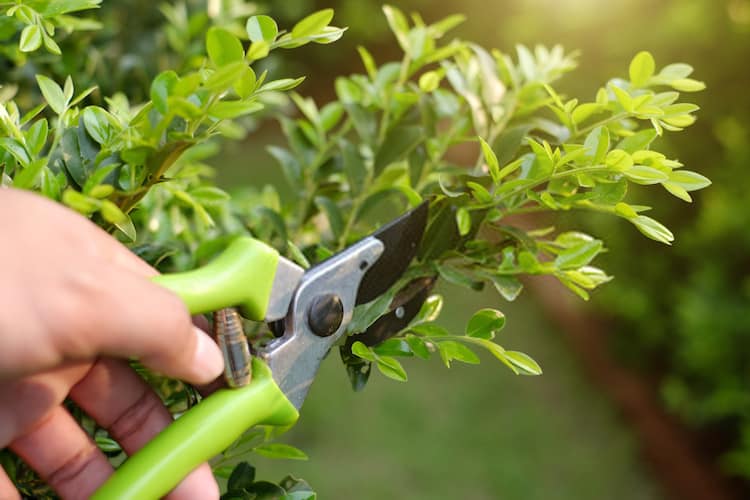Pruning is one of the most common and essential cultural maintenance procedures for woody plants, trees, shrubs, and ornamental trees.
Although trees that grow in the forest do well utilizing just natures help in pruning, landscape trees need a higher level of optimal care and maintenance to preserve their aesthetics and structural integrity.
You may wonder, how does pruning promote growth of plants?
To understand this mechanism, you must, first of all, understand the biology of the tree and prune the tree based on its biological structure and needs. This is because improper pruning can gravely damage a tree or even considerably shorten its life.
Read Also: How To Prevent Branch of Trees From Back
Table of Contents
What is Pruning?

Pruning is both art and science. It is an art as it involves making proper cuts on the tree, while it is science as it consists of having a good knowledge of the tree’s biological structure and knowing where to prune, how to prune and when to prune for best results.
Pruning is a process of controlling plant growth and development by cutting off older dead plant parts to promote new healthier growth or direct the growth toward a specific direction.
Pruning stimulates new growth of the plant, and you can prune a plant either lightly or severely, depending on what you want to achieve with the tree.
Severe pruning is usually carried on trees that have not been pruned at all or that have been pruned a long time ago. Such trees are severely pruned, that it severely cut back in such a way that it will result in rapid growth and springing up of new shoots.
Severe pruning usually results in the vigorous growth of a plant, while light pruning often results in slower growth of cut plant parts.
How Does Pruning Promote Growth?
There are different shoot tips on every plant, and these shoot tips influence the growth of each other in several ways. The main shoots that are growing usually inhibit the growth of other younger shoots.
Therefore, when these main shoots are pruned, the other shoot whose growth was inhibited now becomes stimulated to grow.
To understand how pruning promotes growth, we would learn a little about plant biology and some scientific terms. When a seed grows into a plant, there is just one point of the plant growing. That part is called the terminal or apex bud.
This apex bud continues to grow until it becomes dormant for a while and starts to grow again. This time, it leaves a scar on the plant branch. These scars are often used to determine the age of a tree or limb by counting them.
As the new shoot continues to grow taller, nodes are formed. Nodes are the areas on the shoot where a leaf is attached, and one or more lateral buds are usually produced at each node.
The apex or terminal bud produces auxin and inhibits the plant growth and development of lateral buds beneath it through a phenomenon known as apical dominance.
Apical dominance intensity varies from one plant to another. However, pruning destroys the mechanism of apical dominance and stimulates lateral buds to grow into shoots.
Another way through which pruning promotes growth is by reducing the size of the above-ground part of the plant when compared to the root system. This results in the undisturbed root system servicing a smaller amount of buds and shoots.
This increases the relative uptake of water and nutrients by the remaining shoots and buds, which results in a phase of growth. Thus a re-growth occurs!
If you're wondering what are the best pruners to use on your plants, click here to see our recommended pruners.
When Is the Best Time to Prune
A basic rule of thumb for pruning is to prune during the dormant periods of any plant. In the United States, the latent period of most plants falls between late fall and early spring. Pruning during winter stimulates growth, while pruning during summer slows down growth.
For flowering plants, the best time to prune them in order to stimulate growth is immediately after the flowers have died off. This ensures that in the following spring, there would be an abundance of flowers that are full and growing well.
Some plants such as grapes, maple trees, and birch trees are best pruned in spring, summer, and early fall. The reasons for this special treatment are not known, but it suits them best, and gardeners have taken to practicing it.
The best way to know the ideal time to prune your tree is to determine what your intentions for the plants are and to understand the biology of the plant.
For specific pruning tips with regards to when to prune, you can inquire from your nursery, a good gardening guide on pruning, or consult an online plant platform.
Read Also: How to Cut Overgrown Bushes
Conclusion
Pruning does promote growth by destroying apical dominance, a phenomenon exhibited by many plants that favor the growth of apex or terminal buds while discouraging and inhibiting the growth of lateral buds beneath it.
Pruning also helps direct a plant toward having a definite for improved growth or aesthetic purposes. In all ramifications, pruning is beneficial to plants and should be carried with extreme caution to avoid damaging the entire tree or exposing it to diseases and infections.
So if you've been asking the question "how does pruning promote growth," we believe you have the answer now.





